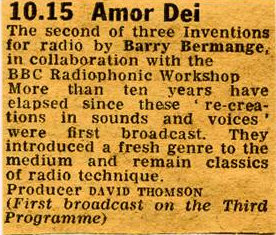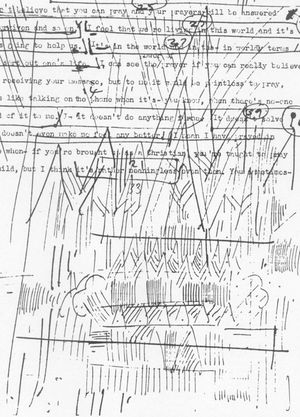Amor Dei
Amor Dei: A Vision of God is the second of the four Inventions for Radio.
A second invention for radio by Barry Bermange, in collaboration with the B.B.C.'s Radiophonic Workshop, with talk recorded in co-operation with the Old People's Welfare Council, Hornsey. Producer: David Thomson. An attempt to describe God in human terms, and to create, in the manner of a religious painting, an overall impression of man's love for Him. The voices were recorded from life and arranged by the author in a setting of radiophonic sound. Plainsong Antiphon John Hahessy (boy soprano) - unacc. 16-Nov-1964. [1]
When I was doing the Inventions with Barry Bermange he wanted sounds which would sound like a Gothic altarpiece. 'Oh,' I said, 'yes. What a good idea. But what do you really mean? What sort of sounds?' He said 'Well, give me a pencil and paper'. I did, and with great care and elaboration he drew me a beautiful Gothic altarpiece and said 'That's the sort of sound I want'. [2]
Barry Bermange said that he himself thought of Amor Dei as ‘rather in the manner of a Renaissance painting with the believers in God in the foreground or centre and half-hidden disbelievers looking out from shadowy places round the edge of the painting.’
He has made this programme in four sections. In the first you will hear several thoughtful voices groping towards God, feeling their way into something undefined. In the second, some more assured voices cite concrete images; a defined notion of God begins to emerge. The third is a contest between those who love God and those who cannot believe in Him. The assured and confident voices in the last section are inspired by absolute faith. [3]
Contents
Structure
There is an extensive analysis of the piece's musical structure and the circumstances surrounding its creation in Special Sound, pp.102-111.
The work is in four movements, each of which has its own page:
1. Groping towards God (7:59)
"Several thoughtful voices groping towards God, feeling their way into something undefined"[3]

2. Rorate Coeli (9:02)
"Some more assured voices cite concrete images; a defined notion of God begins to emerge"[3]
3 samples from Delia's makeup tapes can be heard on its page Rorate Coeli.

3. "I'd like to believe in God, but..." (14:35)
"A contest between those who love God and those who cannot believe in Him"[3]

4. "There IS a God!" (14:27)
"The assured and confident voices in the last section are inspired by absolute faith."[3]

Transcription version
Delia prepared an abridged "transcription" version of the suite for transmission outside the U.K.
Papers
- DD105913: Radio Times clipping for Amor Dei at 8.0 "to be repeated on December 5"
- DD110509: David Thomson's article in the Radio Times
- DD113127: Manuscript
Tapes
- DD171: "Amor Dei 3.75ips Copy"
- DD271: "Amor Dei backgrounds"
- DD272: "Heavenly BG's"
- DD273: "Heavenly Choir"
- TRW 6098: The Initial Catalogue of Delia's tapes says that the programme code for this is TRW 6098.
Copyright
The Performing Right Society's list of works by Delia Ann Derbyshire has:
Title: Amor Dei Publisher: BBC Worldwide Music Work number: 1471909Z Type: 10/00 [?] Work Status Flags: Film/TV / 1st Lic Referral Creation date: 11 August 1999
and its BBC Programme Number is 28SX6836
Availability
- Broadcast by the BBC Third Programme on 16th November 1964, repeated on December 5th.
- A shortened version was played in the Unit Delta Plus Concert of Electronic Music at the Watermill Theatre, Bagnor on the 10th September 1966.
- It was repeated on BBC Radio in the mid seventies.[4]
- In the BBC Sound Archive on tape TRW 6098: "Amor Dei".[5]
- The transcription version is in the BBC Sound Archive on tape TRW 6297: "Amor Dei (for transcription)".[6]
- An excerpt is on TRW 7059.[7]
- The British Library Sound Archive has a recording of this, with catalogue number T1604R BD 1, which can be heard for free by going to the British Library in London.
- The first movement can be downloaded from divShare
References
- ↑ Nigel Deacon in Barry Bermange Radio Plays on www.suttomelms.org.uk
- ↑ Delia in Wee Have Also Sound Houses
- ↑ 3.0 3.1 3.2 3.3 3.4 David Thomson's article "Amor Dei: A Vision of God", Radio Times, 1965.
- ↑ The Radio Times entry for Amor Dei's retransmission in the mid 1970s
- ↑ The Tape Library List entry for TRW 6098.
- ↑ The Tape Library List entry for TRW 6297.
- ↑ The Tape Library List's entry for TRW 7059.

